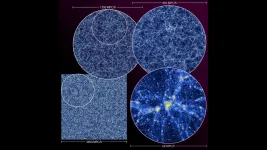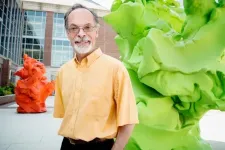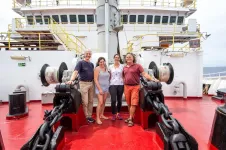In a tight spot
A newly discovered circuit helps fish to prioritize
2021-01-27
(Press-News.org) Being constantly flooded by a mass of stimuli, it is impossible for us to react to all of them. The same holds true for a little fish. Which stimuli should it pay attention to and which not? Scientists at the Max Planck Institute of Neurobiology have now deciphered the neuronal circuit that zebrafish use to prioritize visual stimuli. Surrounded by predators, a fish can thus choose its escape route from this predicament.
Even though we are not exposed to predators, we still have to decide which stimuli we pay attention to - for example, when crossing a street. Which cars should we avoid, which ones can we ignore?
"The processes in the brain and the circuits that lead to this so-called selective attention are largely unexplored," explains Miguel Fernandes, a postdoctoral researcher in Herwig Baier's department. "But if we understand this in a simple animal model like the zebrafish, it can give us fundamental insights into decision-making mechanisms in humans."
For this reason, Miguel Fernandes and his colleagues studied the behavior of zebrafish in the predicament described above: Using virtual reality, the team simulated two predators approaching a fish from the left and right at the same speed. In most cases, the fish focused on one of the two predators and fled in the opposite direction. They thus integrated only one, the so-called "winner stimulus", into their escape route (winner-take-all strategy).
However, in some cases, the fish evaluated both stimuli and swam through the middle (averaging strategy). This showed that fish are in principle able to include both threats in their escape way. However, they usually pay attention to only one stimulus.
Two brain regions involved
With the knowledge gained from this behavioral analysis, the researchers investigated which brain regions are active during stimulus selection. In the nearly transparent zebrafish, they identified under the microscope two brain regions: the tectum, the processing hub for visual stimuli, and an appendage of it, the so-called nucleus isthmi (NI).
To determine the role of the NI more precisely, the researchers inactivated neurons in this brain region. Interestingly, in virtual reality experiments, the fish now used predominately the averaging strategy instead of the winner-take-all strategy - a sign that the NI plays a crucial role in determining a winner-stimulus.
By tracking down the cell extensions of the neurons, the scientists decoded the circuit between the two brain regions: Tectal neurons extend to the NI, whose cells, in turn, innervate the tectum. This creates a feedback loop that enhances the signals of winner-stimuli in the brain. All other stimuli classified as unimportant, on the other hand, are suppressed.
With this newly discovered circuit, the brain assigns a specific level of importance to all optical perceptions. As a basis for decision-making, this allows fish to react to important stimuli and ignore unimportant ones. Researchers can now continue to investigate for example how experience or stress influence the fish's reaction.
INFORMATION:
Original publication
António M. Fernandes, Duncan S. Mearns, Joseph C. Donovan, Johannes Larsch, Thomas O. Helmbrecht, Yvonne Kölsch, Eva Laurell, Koichi Kawakami, Marco Dal Maschio, Herwig Baier
Neural circuitry for stimulus selection in the zebrafish visual system
Neuron, 23 December 2020
[Attachments] See images for this press release:

ELSE PRESS RELEASES FROM THIS DATE:
2021-01-27
A massive simulation of the cosmos and a nod to the next generation of computing
A team of physicists and computer scientists from the U.S. Department of Energy's (DOE) Argonne National Laboratory performed one of the five largest cosmological simulations ever. Data from the simulation will inform sky maps to aid leading large-scale cosmological experiments.
The simulation, called the Last Journey, follows the distribution of mass across the universe over time -- in other words, how gravity causes a mysterious invisible substance called "dark matter" to clump ...
2021-01-27
Many genetic mutations have been found to be associated with a person's risk of developing Parkinson's disease. Yet for most of these variants, the mechanism through which they act remains unclear.
Now a new study in Nature led by a team from the University of Pennsylvania has revealed how two different variations--one that increases disease risk and leads to more severe disease in people who develop Parkinson's and another that reduces risk--manifest in the body.
The work, led by Dejian Ren, a professor in the School of Arts & Sciences' Department of Biology, showed that the variation that raises disease risk, which about 17% of people possess, causes a reduction in function of an ion channel ...
2021-01-27
Dr. Richi Gill, MD, is back at work, able to enjoy time with his family in the evening and get a good night's sleep, thanks to research. Three years ago, Gill broke his neck in a boogie board accident while on vacation with his young family. Getting mobile again with the use of a wheelchair is the first thing, Gill says, most people notice. However, for those with a spinal cord injury (SCI), what is happening inside the body also severely affects their quality of life.
"What many people don't realize is that a spinal cord injury prevents some systems within the body from regulating automatically," ...
2021-01-27
Among infectious diseases that have caused pandemics and epidemics, smallpox stands out as a success story. Smallpox vaccination led to the disease's eradication in the twentieth century. Until very recently, smallpox vaccine was delivered using a technique known as skin scarification (s.s.), in which the skin is repeatedly scratched with a needle before a solution of the vaccine is applied. Almost all other vaccines today are delivered via intramuscular injection, with a needle going directly into the muscle, or through subcutaneous injection to the layer of tissue beneath the skin. But Thomas Kupper, MD, chair of the Department of Dermatology, and colleagues, had reason to suspect that vaccines delivered ...
2021-01-27
URBANA, Ill. - With cities around the globe locking down yet again amid soaring COVID-19 numbers, could seasonality be partially to blame? New research from the University of Illinois says yes.
In a paper published in Evolutionary Bioinformatics, Illinois researchers show COVID-19 cases and mortality rates, among other epidemiological metrics, are significantly correlated with temperature and latitude across 221 countries.
"One conclusion is that the disease may be seasonal, like the flu. This is very relevant to what we should expect from now on after the vaccine controls these first waves of COVID-19," says Gustavo ...
2021-01-27
An upsurge of matter from deep beneath the Earth's crust could be pushing the continents of North and South America further apart from Europe and Africa, new research has found.
The plates attached to the Americas are moving apart from those attached to Europe and Africa by four centimetres per year. In between these continents lies the Mid-Atlantic Ridge, a site where new plates are formed and a dividing line between plates moving to the west and those moving to the east; beneath this ridge, material rises to replace the space left by the plates as they move apart.
Conventional wisdom is that this process is normally driven by distant gravity forces as denser parts of the plates sink back into the Earth. However, the driving force behind the separation of the Atlantic ...
2021-01-27
Scientists have resolved a key climate change mystery, showing that the annual global temperature today is the warmest of the past 10,000 years - contrary to recent research, according to a Rutgers-led study in the journal Nature.
The long-standing mystery is called the "Holocene temperature conundrum," with some skeptics contending that climate model predictions of future warming must be wrong. The scientists say their findings will challenge long-held views on the temperature history in the Holocene era, which began about 12,000 years ago.
"Our reconstruction shows that the first half of the Holocene was colder than in industrial times due to the cooling effects of remnant ice sheets from the previous glacial period - contrary to previous reconstructions of global temperatures," ...
2021-01-27
STOCKHOLM: With impacts from climate change threatening to be as abrupt and far-reaching in the coming years as the current pandemic, leading scientists have released a compilation of the 10 most important insights on the climate from the last year to help inform collective action on the ongoing climate crisis.
In a report presented today to Patricia Espinosa, Executive Secretary of the United Nations Framework Convention on Climate Change (UNFCCC), report authors outlined some of 2020's most important findings within the field of climate science, ranging from improved models that reveal the need for aggressive emission cuts in order to meet the Paris Agreement to the growing use of human rights litigation to catalyze climate action.
The report alleviates some worries that ...
2021-01-27
In experiments at the Paul Scherrer Institute PSI, an international research collaboration has measured the radius of the atomic nucleus of helium five times more precisely than ever before. With the aid of the new value, fundamental physical theories can be tested and natural constants can be determined even more precisely. For their measurements, the researchers needed muons - these particles are similar to electrons but are around 200 times heavier. PSI is the only research site in the world where enough so-called low-energy muons are produced for such experiments. The researchers are publishing their results today in the journal Nature.
After hydrogen, helium is the second most abundant element in the universe. Around one-fourth of the ...
2021-01-27
People with schizophrenia, a mental disorder that affects mood and perception of reality, are almost three times more likely to die from the coronavirus than those without the psychiatric illness, a new study shows. Their higher risk, the investigators say, cannot be explained by other factors that often accompany serious mental health disorders, such as higher rates of heart disease, diabetes, and smoking.
Led by researchers at NYU Grossman School of Medicine, the investigation showed that schizophrenia is by far the biggest risk factor (2.7 times increased odds of dying) after ...
LAST 30 PRESS RELEASES:
[Press-News.org] In a tight spot
A newly discovered circuit helps fish to prioritize




